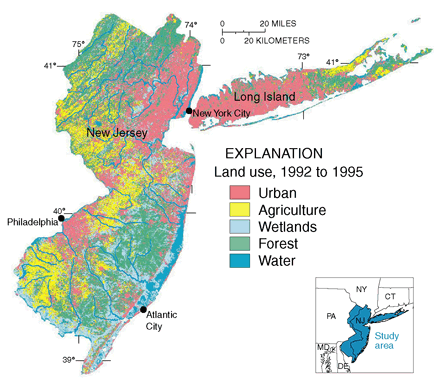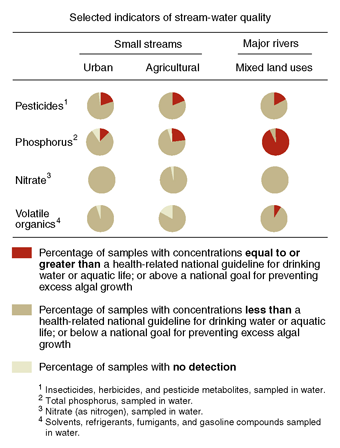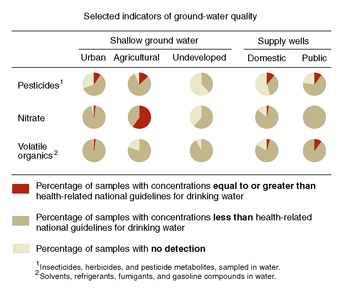SUMMARY OF MAJOR FINDINGS
Stream and River Highlights
 |
| Land use is a primary factor affecting the quality of water resources in the Long Island–New Jersey Coastal Drainages study area. |
Human activities associated with urban and agricultural land use are the primary factors that affect the quality of streams and the health of aquatic life throughout Long Island and New Jersey (see map on right). Although concentrations of most chemical constituents detected in stream samples generally meet Federal and State water-quality guidelines, current guidelines do not address many of these chemicals nor the combinations (mixtures) of pesticides, fertilizers, and industrial and fuel-related compounds (volatile organic compounds, or VOCs) that were commonly detected in all streams. Concentrations of trace elements and organic compounds in streambed sediment in urban areas commonly failed to meet guidelines for protection of aquatic life, but sediment quality did not appear to be as influential as other human-related factors in affecting aquatic community health. Rather, study findings indicate that urban and suburban evelopment, especially when it replaces forest and wetlands, results in changes in the natural flow of streams, habitat degradation, reduction in biological diversity, and a shift toward species more tolerant of disturbance. These factors together likely have a greater effect on impairment of aquatic life than on drinking-water quality in highly urbanized areas.
- Impaired aquatic communities in urban areas were related to increases in impervious surfaces, in the amount and fluctuation in storm runoff, and in chemical use; impairment also was related to decreases in base flow, in forest and wetland area, and in stream-habitat quality (p. 8).
- Widespread historical use and environmental persistence of chlordane, dieldrin, DDT, polychlorinated biphenyls (PCBs), and polycyclic aromatic hydrocarbons (PAHs), particularly in urban areas, have resulted in frequent detection of these compounds in streambed and lake sediments and, except for PAHs, in fish tissue (p. 9 and 14).
- Concentrations of most trace elements in streambed and lake sediments were elevated in urban watersheds relative to those in less developed watersheds (p. 10).
- Concentrations of nitrate generally were lower in streams than in ground water (p. 15). Modeling analysis indicates that this is a result of microbial, physical, and (or) chemical processes in or near the stream (p. 16).
- Elevated concentrations of nitrate and widespread low concentrations of pesticides were detected in streams in agricultural and urban areas (p. 15 and 18).
- Concentrations of pesticides in some agricultural streams during periods of high runoff in late spring and early summer, soon after crop application, exceeded drinking-water guidelines (p. 18).
- Nonpoint urban contaminant sources, especially in commercial and industrial
areas, were major contributors to the widespread presence of VOCs at
low concentrations in streams (p.
21).
 |
Trends in Stream Quality
- Stream quality, as indicated by fish-community measures, improved from the 1970s to the 1990s largely as a result of wastewater-treatment-plant upgrades implemented under provisions of the Clean Water Act (p. 5).
- Concentrations of lead, DDT, PCBs, chlordane, and dieldrin in lake-sediment cores have declined since regulatory actions discontinued their production and use; however, concentrations of zinc and PAHs in urban lake-sediment cores have steadily increased over time as a result of their association with increasing vehicular traffic and fossil-fuel use, respectiviely (p. 14).
| Major Influences on Stream Quality
|
About 40 percent of the domestic (household) and public drinking-water supply in the study area is obtained from ground water that is replenished by precipitation that infiltrates the soil and drains to the water-table (surficial) aquifer. Elevated concentrations of nitrate and the frequent detection of pesticides and VOCs in water samples from surficial aquifers indicate that the aquifers are vulnerable to chemicals used in agricultural and urban areas.
Concentrations of nitrate in samples of shallow ground water underlying agricultural areas in southern New Jersey and agricultural and suburban areas on Long Island frequently exceeded drinking-water guidelines. The use of nitrogen fertilizers to support crop production and the use of septic systems in these areas, combined with the presence of well-drained and aerated soils, favor the formation of nitrate and its movement to ground water. Pesticide and VOC concentrations in water samples from surficial aquifers in New Jersey generally were low and rarely exceeded drinking-water guidelines; concentrations generally were greater in samples from the Long Island surficial aquifer system. Drinking-water standards or guidelines have not been established for 31 and 34 percent of the pesticides and VOCs detected, respectively.
Although human activities associated with agricultural and urban land uses are the principal sources of contaminants in ground water, factors other than land use can affect ground-water quality. For example, some pesticides that are known to be used extensively were not detected in ground water because they degrade readily or are not mobile. Additionally, some constituents, such as arsenic and radium, were detected in water where surficial sediments or geologic formations are known to contain these elements.
- Arsenic was frequently detected in samples from domestic wells in the Piedmont Physiographic Province (p. 12).
- Radium concentrations in one-third of 177 water samples from the surficial aquifer system in southern New Jersey exceeded the Federal drinking-water guideline (p. 13).
- The median concentration of nitrate in samples of shallow ground water underlying agricultural areas in the Coastal Plain of New Jersey was the highest nationwide among 47 similar ground-water surveys conducted to date by the NAWQA Program (p. 15).
- The most frequently detected pesticide compounds were herbicides and their breakdown products (p. 18); however, the most commonly used pesticides were not necessarily the most frequently detected in ground water (p. 20).
- VOCs were detected more frequently, and at higher concentrations, in samples of shallow ground water underlying urban areas than in those from agricultural or undeveloped areas (p. 23), and in samples of untreated water from public-supply wells than in those from shallow monitoring or domestic wells (p. 24).
- Nearly all samples from public-supply wells contained two or more pesticides and (or) VOCs (p. 25). Drinking-water guidelines do not address exposure to multiple compounds.
 |
Trends in Ground-Water Quality
A computer model study of the surficial aquifer system in southern New Jersey indicates that the concentration of nitrate in streams and public-supply wells is related to the type of land use in the recharge area and the time required for the recharge water to reach the stream or well (p. 16).
Model results also indicate that years or even decades will be required before reduction in nitrate use will produce substantial decreases in the concentrations of nitrate in streams and ground water. If nitrate use remains at current levels, nitrate concentrations in streams and ground water in agricultural and urban parts of the study area will continue to increase for several decades (p. 17).
| Major Influences on Ground-Water Quality
|
| Table of Contents || Previous Section || Next Section || Glossary U.S. Geological Survey Circular 1201 Suggested citation:
|

